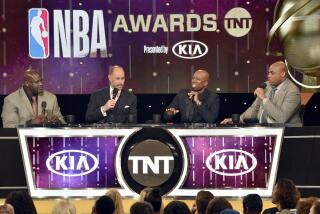Bailey Couldn’t Be Happier Back in Utah Leading Jazz
- Share via
SALT LAKE CITY — Most members of the Utah Jazz hate the theatrics before home playoff games. Not Thurl Bailey.
Fireworks streak toward the ceiling and unleash deafening booms, covering the Delta Center and everyone in it with a thin layer of ash. The Jazz Dancers frolic as the team’s mascot, Bear, rides a huge motorcycle to center court, revving the engine while the league’s noisiest fans scream their lungs out.
His teammates mostly cover their ears and grimace, but Bailey savors the noisy, smoky, frantic atmosphere for just a moment.
“To get the chance to be in the playoffs at this point in my career
Bailey is 38, the oldest player on one of the league’s oldest teams. He first came to the Jazz in 1983, and he spent eight years in their old green, purple and gold uniforms, playing an important part in Utah’s rise from a basketball Siberia to the league’s upper echelons.
Eight years later, after sojourns in Minneapolis, Greece and several cities in Italy, Bailey is back with the Jazz at an age when most basketball players have moved on to other things.
“In that sense, Thurl is an inspiration,” Utah coach Jerry Sloan said. “He kept himself ready for another chance, and now that it’s come, he’s making the most of it.”
Bailey wasn’t sure he’d ever return.
“I thought I could still play at this level if I was given a chance, but I had to accept the fact that maybe I wouldn’t fit with a team,” he said. “I’m glad I was wrong.”
Bailey has won a title before. He was a key player at North Carolina State the year Jim Valvano’s troops upset Akeem Olajuwon and Houston in the 1983 NCAA championship game. The Jazz made him the seventh overall pick in that year’s draft, and he quickly became a franchise cornerstone.
Bailey was one of the game’s best sixth men as well as a frequent starter for the Jazz, often using his 6-foot-11 body to dominate small forwards. His best years were 1987-89, when he averaged over 19 points and six rebounds a game.
“Thurl has always been that really dependable player that every team needs,” said Karl Malone, who joined the Jazz two years after Bailey. “We had a lot of great years here while we were coming up in the league. That was a special time for a lot of young guys here.”
The Jazz traded Bailey in 1991, and he played three seasons with Minnesota before dropping out of the league.
Bailey then headed to Greece, playing one season with Panionios before three years in the Italian League with Polti Cantu and Milano. He led his league in blocked shots each of the four years he played in Europe, and was the high scorer on Polti Cantu’s championship team in 1996.
“I had wonderful times in Europe, but it’s hard to be away from the people and things you care about,” Bailey said.
His second wife, Sindi, is a Utah native, and the couple made their offseason home in Salt Lake. Two of Bailey’s children from his first marriage also live in Utah. After four years of globetrotting, he had had enough.
The Bologna club in Italy’s top league offered Bailey truckloads of lira for another season. The offer went higher when Bailey appeared to be leaning toward staying in the United States.
“It was time to move on,” Bailey said. “I wanted the challenge of trying the NBA again. It was something I had to find out about myself.”
So, he began playing in a daily pickup game at Salt Lake’s Westminster College with John Stockton, Jeff Hornacek and a revolving roster of NBA players and wannabes. As the lockout dragged on, he drew attention with his smooth game.
“We could tell Thurl still had what it takes,” Stockton said. “He’s a hard worker, and you could tell he really wanted to stick with” the Jazz.
The team invited Bailey to training camp, though no one in the organization thought much of his chances to make the team.
“We’ve invited him. We owe him that. He played for the franchise back when it needed him. He did a good job ... so, we owe him that,” Jazz vice president of basketball operations Scott Layden told The Salt Lake Tribune at the time.
But then a chain of events left the Jazz needing a big man. Utah went after free agent LaPhonso Ellis, and an irked Antoine Carr signed with Houston. When Ellis spurned the Jazz for Atlanta days before the regular season began, Bailey was the man on the spot.
“Good timing is part of life,” Bailey said. “God had a plan for me to be in a good situation, and that’s what happened.”
He played in 43 of Utah’s games this year, providing solid defense and the occasional offensive spark. At 38, there are limitations to his game, but “my experience gets me through a lot of things,” he said.
Life is good in Utah for Bailey, who converted to Mormonism, the state’s dominant faith, while he played in Italy. He’s able to watch his children grow up, instead of talking to them on the phone late at night from a hotel room in Italy. He recently released an album of original songs, including a duet with country musician Billy Dean.
Bailey and fellow newcomer Todd Fuller, the only additions to Utah’s roster this season, basically split the minutes that were played by Carr in years past. On and off the court, Bailey makes the most of his time, as shown in Game 1 of the Jazz’s conference semifinal series against Portland.
Bailey played just seven minutes but hit the only two shots he took, including a jumper that beat the shot clock and tied the game in the fourth quarter. When Bailey’s unique, twisting jump shot found the net, Jazz PA announcer Dan Roberts bellowed a call he revived this year after eight years in storage: “Big T, Thurl Bailey! T for two!”
“It’s good to be home,” Bailey said.
More to Read
Go beyond the scoreboard
Get the latest on L.A.'s teams in the daily Sports Report newsletter.
You may occasionally receive promotional content from the Los Angeles Times.










